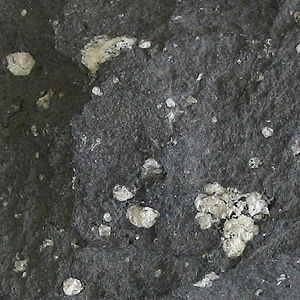Difference between revisions of "Andesite" - New World Encyclopedia
| Line 54: | Line 54: | ||
== External links == | == External links == | ||
| − | *[http://geology.csupomona.edu/alert/igneous/texture.htm Igneous Rock Textures] | + | *[http://geology.csupomona.edu/alert/igneous/texture.htm Igneous Rock Textures.] ''Project Alert NASA/CSU''. Retrieved May 18, 2007. |
| − | + | *[http://www.nsm.buffalo.edu/courses/gly206/SubductionMagmas.pdf Subduction Magmas: Island arc magmatism.] Retrieved May 18, 2007. | |
| − | *[http://www.nsm.buffalo.edu/courses/gly206/SubductionMagmas.pdf Island arc magmatism] | + | |
| − | *[http://www.margins. | + | * [http://www.nsf-margins.org/Eugene_PDF/SubFac_abstract_Gaetani.pdf Experimental and Theoretical Constraints on Peridotite Partial Melting in the Mantle Wedge.] Retrieved May 18, 2007. |
[[Category:Physical sciences]] | [[Category:Physical sciences]] | ||
Revision as of 19:56, 18 May 2007

Andesite is an igneous, volcanic rock, of intermediate composition, with aphanitic to porphyritic texture. The mineral assembly is typically dominated by plagioclase plus pyroxene and/or hornblende. Biotite, quartz, magnetite, sphene are common accessory minerals. Alkali feldspar may be present in minor amounts. The quartz-feldspar abundances in andesite and other volcanic rocks are illustrated in QAPF diagrams. Relative alkali and silica contents are illustrated in TAS diagrams.
Classification of andesites may be refined according to the most abundant phenocryst. Example: hornblende-phyric andesite, if hornblende is the principal accessory mineral.
Andesite can be considered as the extrusive equivalent to plutonic diorite. Andesites are characteristic of subduction tectonic environments in active oceanic margins, such as the western coast of South America. The name andesite is derived from the Andes mountain range.
Genesis of andesite
Andesite is formed at accretionary plate margins. Intermediate volcanic rocks are created via several processes:
- Dehydration melting of peridotite and fractional crystallization
- Melting of subducted slab containing sediments
- Magma mixing between felsic rhyolitic and mafic basaltic magmas in an intermediate reservoir prior to emplacement or eruption.
Via fractional crystallisation
Andesitic magma in island arc regions (i.e. active oceanic margins) comes from the interplay of the subducting plate and the mantle wedge, the part of the overriding plate above the subducted plate.
Water in the subducted oceanic crust 'boils off' from the slab by dehydration of hydrated minerals such as amphibole, zeolites, chlorite etc, which are formed in oceanic crust during hydrothermal circulation at the mid-ocean-ridge spreading centre. As these minerals are subjected to Barrovian Facies Sequence or Franciscan Facies Sequence metamorphism during subduction, they metamorphose to more stable, dehydrated forms, releasing water and volatile elements into the mantle wedge.
The slab itself, or the overlying mantle wedge, may melt. Melting subducted slab components have a sediment component from the subducted plate, which can be detected by increased lead and barium in the melts which are produced. The water and initial slab melts rise into the mantle wedge, prompting melting of the peridotite to produce a basaltic melt with a distinct subduction signature in its trace element composition (eg, shoshonite, adakite).
On its way to the surface, the melt stalls and cools, enabling the fractional crystallization of silica poor minerals, thus raising the silica content of the remaining melt and resulting in andesitic magma.
Via magma mixing
Basaltic magma may also mix with rhyolitic magma. This usually occurs in continental arc areas such as the Andes, where the high geothermal gradient above the subducted plate, and hydrothermal flows within the mantle wedge may create an underplate of softened, partially molten continental crust of intermediate or felsic composition. Basaltic magmas intruded into this anomalously hot zone will prompt partial melting of the crust, and may mix with these melts to produce intermediate compositions, typically andesite to trachyte in composition.
Alternatively, the basaltic melt may heat up the overlying arc, prompting partial melting, and may even assimilate sediments, previous volcanic rocks, etcetera, whilst undergoing fractional crystallisation. These rocks are subordinate due to the difficulty in assimilating sufficient cold material by magmas without cooling to a degree that they become immobile.
Ultimately, the resultant composition of andesite and intermediate magmas is the result of fractional crystallisation, assimilation, partial melting and contaminaton by the subducted slab. These may take considerable effort to resolve the individual components.
See also
- List of rocks
- Continental crust
- Oceanic crust
- Metamorphism
- Granite
- Fractional crystallization
- Andesite line
- Porphyry
ReferencesISBN links support NWE through referral fees
- Blatt, Harvey, and Robert J. Tracy. 1995. Petrology: Igneous, Sedimentary, and Metamorphic, 2nd ed. New York: W.H. Freeman. ISBN 0716724383.
- McBirney, Alexander R. 2006. Igneous Petrology. 3rd ed. Jones & Bartlett. ISBN 0763734489.
- Pellant, Chris. 2002. Rocks and Minerals. Smithsonian Handbooks. New York: Dorling Kindersley. ISBN 0789491060.
- Skinner, Brian J., Stephen C. Porter, and Jeffrey Park. 2004. Dynamic Earth: An Introduction to Physical Geology. 5th ed. Hoboken, NJ: John Wiley. ISBN 0471152285.
External links
- Igneous Rock Textures. Project Alert NASA/CSU. Retrieved May 18, 2007.
- Subduction Magmas: Island arc magmatism. Retrieved May 18, 2007.
- Experimental and Theoretical Constraints on Peridotite Partial Melting in the Mantle Wedge. Retrieved May 18, 2007.
Credits
New World Encyclopedia writers and editors rewrote and completed the Wikipedia article in accordance with New World Encyclopedia standards. This article abides by terms of the Creative Commons CC-by-sa 3.0 License (CC-by-sa), which may be used and disseminated with proper attribution. Credit is due under the terms of this license that can reference both the New World Encyclopedia contributors and the selfless volunteer contributors of the Wikimedia Foundation. To cite this article click here for a list of acceptable citing formats.The history of earlier contributions by wikipedians is accessible to researchers here:
The history of this article since it was imported to New World Encyclopedia:
Note: Some restrictions may apply to use of individual images which are separately licensed.